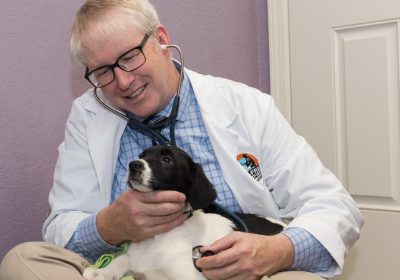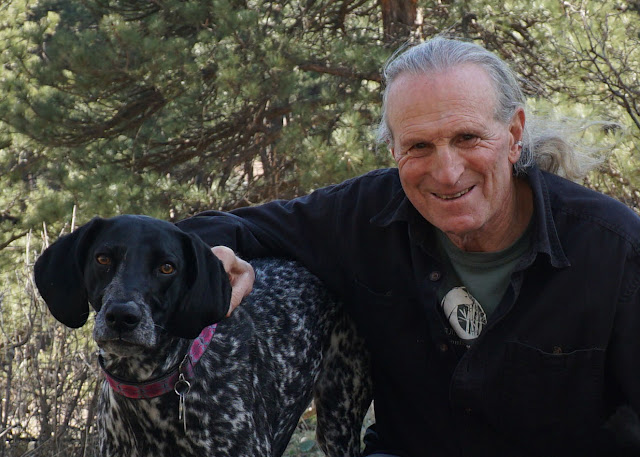Recently I wrote about desensitization and counter-conditioning in dog training, an important technique to help fearful dogs. As a talented dog trainer who helps clients with fearful and aggressive dogs, Jane Sigsworth uses this technique often. I spoke to her to learn about some of her case studies – and the holiday cottage where reactive dogs can roam free.
Zazie: How did you get into dog training?
Jane: A long time ago I had a dog who, looking back, didn’t really have many issues, but I felt he did at the time. He was a big barker and I was concerned about what my neighbours would think about him. So I started to look for information about how to deal with it and went on what can only be said was a very circuitous route initially. I did courses and workshops that didn’t contain good information. At the time I didn’t know anything so I didn’t know any better back then, put it that way. It was really to solve my own dog’s problems, but it wasn’t meant to be a career change. It became a quality of life issue for my husband and I. We spent the first 16 years of marriage always living apart because of our jobs and shifts. That’s why, in the end, I decided to make the career change to have a better quality of life, but that wasn’t initially my intention. Really the short answer is to solve my first dog’s issues.
Zazie: I think that probably applies to a lot of people, that they find their way into dog training because of a problem (or something that’s perceived as a problem). So, tell me about your business.
Jane: I have two sides to my business. I have Dog Knowledge, which is my behaviour and training side. I run puppy and adult training classes, and I do one-to-one behaviour consultations and training appointments, and a little bit of day training. The training classes are at a venue but the rest of the time I’m fairly mobile in where I work, either working from the places that I do my training classes or I go to people’s houses.
"Just a couple of weeks ago the vet was able to listen to his heart for the first time, to get close enough."
And then the other side of my business is Holiday With Your Dogs, which is a holiday cottage. It stemmed from my interest in fear and aggression issues, because I realized there are a lot of people who had issues with their dog and couldn’t come and go and let them off-lead because they felt that they were aggressive towards other dogs or they didn’t like strangers. And also people with dogs like retired racing Greyhounds that couldn’t let them off the lead because they were afraid they’d kill the neighbour’s cat. So the holiday cottage started out of that but it’s kept quite separate to my behaviour business. I like people to be able to come and have a relaxing holiday. Not many guests know what I do for a living because I don’t want them thinking that I’m looking at them in the field and thinking ‘well that’s why you’ve got a problem, you’re doing X, Y and Z.’ So I do tend to keep the two sides of the business very separate, but the holiday cottage business came about because I realized that there weren’t very many safe places where people could go and were comfortable letting their dogs off-lead, and also people with multiple dogs. You know if you’ve got five or six dogs, where can you go on holiday with your dogs? Where can you take them? So that’s the two sides to the business.
Zazie: That’s fantastic. I think it’s so useful and relaxing for people to have somewhere like that to go. How would you describe the area in which your holiday cottage is?
Jane: Stunningly beautiful! It’s located in the Cothi Valley in south-west Wales so it’s very lushly green everywhere all year round. And they’ve got 22 acres of secure paddocks where they can just come. It’s been designed like a country park so there’s woodlands and walks and dog waste bins and benches and picnic tables and things all around. So it makes it feel like they’re in a country park but they’re not having to look over their shoulder. So they can come to a beautiful part of the world. It’s quite rural, you don’t want to be looking for a cash point [ATM] locally – well we do have one not too far away but certainly not supermarkets and things.
Zazie: It sounds gorgeous! So back to your dog training business, I was wondering if you could give me an example of when you use classical conditioning to help a client’s dog?
Jane: A lot of my work involves fear and also aggression. It tends to be dogs that have resource guarding issues, either dog-dog guarding issues or dogs to people guarding issues. Also body handling issues, dogs that dislike grooming or any hands coming towards them. And fear of strangers whether that’s globally – anybody new – or just particular types of people. Men or children are the common ones. They would be the three main areas where I use classical conditioning in my work. But because I do a lot of dog-dog work where fear isn’t an issue, one of the prerequisites for the work that I do, if I’m going to be introducing dogs and we don’t have known play histories, a prerequisite would be that the client’s dog is muzzle trained. I would use classical conditioning then because it might be they’ve never seen a muzzle before so they don’t have any fear or anxiety about the muzzle, but we don’t want to be just putting it on their faces. So we would enlist classical conditioning techniques in order to help the dog feel comfortable wearing the piece of equipment before we’re going to go and put them in a field with another dog. They’re the main areas that I use classical conditioning.
Zazie: Do you think there are any aspects of it that clients find particularly hard?
Jane: Yes, I think clients do find it difficult. It’s not intuitive to them. They hear all the time about reinforcing the behaviour that they want and not reinforcing the behaviour that they don’t want, so it feels wrong to them to be what they think is rewarding unwanted behaviour. It’s difficult to get their head around the fact that classical conditioning isn’t behaviour-dependent. I would always recommend, if there’s fear and aggression there, for clients to get professional help because a professional is going to get them through the protocol so much faster and more efficiently than trying to do it themselves. I think the technical aspects of classical conditioning are quite difficult for people. There’s aspects of getting the order of events correct. I think owners can be so focussed on thinking ‘I’ve got to feed, feed, feed, I’d better get a handful of food out now because a stranger’s just walked around the corner’. They might have seen the stranger before their dog has, so they can get the order of events incorrect. I think classical conditioning is really tough for people to do, to maintain the one-to-one ratio and to not get their CSs and USs in the wrong order. I think it’s really tough for owners.
Zazie: I think you’re right. I wonder if you could talk me through a case study?
Jane: I’ve got tons of case studies! These are a couple of my cases at the moment. I’ve got a dog called Sasha who’s a 16-month old Siberian Husky. She’s got quite bad body-handling issues. It started off as growling and then progressed to snapping at her owners and she occasionally catches their arms when they go to put the harness over her head. They persevered thinking that the harness was going on to take her for a walk and so she’d enjoy the walk and get used to the harness. But actually all she’s done is sensitize to it, and now any hands coming towards her for anything, or even if it’s not necessarily going towards her but she catches it out of her peripheral vision, she’s snapping. She’s getting pre-emptive snaps in. So with her, we’ve used classical conditioning. We got a new harness and a new lead so they didn’t come with any existing negative CERs. And I’ve been working with the owners with a protocol to help her change the way that she feels about first of all seeing the equipment. Now over time the equipment has reliably predicted great things happening and we’ve slowly progressed to the harness going over her head. The sound of the clips was a little bit loaded for her so we’ve worked on all those aspects until now she’s comfortable with the harness going on. And we’re working with members of the family because it’s quite a big family that lives with her and some of them are a bit scared of her now to be honest, so some of it is working with them. But that’s going really well and I’m really pleased with that. She’s learning that the new harness predicts all things great.
"I realized that there weren’t very many safe places where people could go and were comfortable letting their dogs off-lead"
Another case is a dog called Rocky who’s a 12-month old Border Collie. He’s terrified of all strangers globally, it doesn’t matter whether they’re children, females, men, men with beards, men wearing crash helmets, it doesn’t matter. He’s just afraid of anybody new. That’s been a case of using classical conditioning and the usual protocols to help him learn that strangers and new people predict great things are happening. Going back to clients finding it difficult, he’s really struggling with the technique. Even though the training sessions with me are going really really well, and I’ve talked to him about not walking the dog in areas where he’s going to be in close proximity to people that will take him over threshold, the owner finds that really hard to get his head around. He has a dog, dogs need walking, going to the park is a nice place to walk even if it’s bank holiday weekend when it’s going to be packed. And that's why he got the dog, so that's hard.
Archie, my own dog, he’s a Saluki-mix, basically a desert dog from Abu Dhabi. I guess genetically not programmed to live in captivity. He came with major body handling issues and major fear of people and just global anxiety about anything. If it existed, he was afraid of it. With him, he’s on medication. It’s been a long journey because in Abu Dhabi we couldn’t get meds for him, anti-anxiety meds. So since we’ve been back we’ve been working on finding the right medication and the right dose, which has helped enormously and we’ve made great strides since we’ve been back. Part of that has been The Husbandry Project [from the Academy for Dog Trainers]. I’ve been part of that, working with him, doing the preparatory work and then taking him to the vet, which is amazing. Just a couple of weeks ago the vet was able to listen to his heart for the first time, to get close enough.
Zazie: Wow!
Jane: He went into lateral recumbency and stationed in the vet room and she listened to his heart, and we were kind of pulling these faces. We wanted to scream and say “Yay!!!” So that was really nice. It just shows you the power of this method. Before that he had to be muzzled, it was deeply traumatic for all concerned if we had to take him to the vet. So they’ve not been able to get a lot of hands on with him before. He’s doing really well!
"I spend a lot of time with recalls because I think it’s the most important behaviour"
Zazie: That’s such a wonderful change. Brilliant. Now, what’s your favourite thing to teach clients and their dogs?
Jane: I have loads! My absolute favourite thing is to have off-lead play in puppy socialization classes, and to teach clients about play behaviour, consent tests, and normal dog behaviour. I absolutely love that. When you have people who are really nervous and uptight if there’s any growling or pinning down and then you see them develop and say ‘well I’ll do a consent test but I know he’s going to run straight back in to play’ and they do that and feel comfortable about it. I absolutely love that.
In terms of behaviours, I love teaching recalls [coming when called]. I spend a lot of time with recalls because I think it’s the most important behaviour. If they don’t get anything else on board I always think at least recall is a life-saving behaviour. So I’m really trying to teach them to build strong recalls and do lots of different games and things with recall to make it fun for them and the dog. I think those are my favourites.
Zazie: Tell me about your dogs.
Jane: I have four dogs. They’re all rescues. They all have various issues. My two English dogs came with aggression issues. I guess this is why I’ve been drawn to fear and aggression issues because of the dogs, and I probably select those kind of dogs. Those two are great now. Then I’ve got Archie who is fearful of everything and aggressive to make the stimulus go further away. Then I’ve got Alfie who will run away and hide and make himself really small because he’s a bit scared of things.
Zazie: Thank you!
Companion Animal Psychology has published interviews with talented scientists, writers, trainers and veterinarians who are working to promote good animal welfare. See the full list or subscribe to learn more about how to have happy dogs and cats.
About Jane Sigsworth:
Jane Sigsworth holds a Master's degree with Distinction in Applied Animal Behaviour and Welfare from Newcastle University. She is also an honours graduate of the prestigious Academy for Dog Trainers. She has over fifteen years' of experience in private consulting and animal rescue centre work.
This interview has been lightly edited for space and some dogs’ names have been changed.
Companion Animal Psychology is a participant in the Amazon Services LLC Associates Program, an affiliate advertising program designed to provide a means for sites to earn advertising fees by advertising and linking to Amazon.com and affiliated sites. Companion Animal Psychology is also a participant in the Etsy Affiliate Program, an affiliate advertising program designed to provide a means for sites to earn advertising fees by advertising and linking to Etsy.com.

















